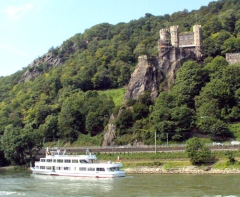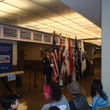Rhine: Castles were 'killing zones made of stone'
Beautiful? No doubt. But a castle's purpose was to kill

View Photo Gallery »
When you think of castles, do you envision Walt Disney’s “Sleeping Beauty” castle? The regal Heidelberg Castle? The towering Neuschwanstein? Forget it. All romance.
For a more accurate — but chilling — description, ask Dr. George Neblett, professor with the University of Maryland, University College.
“It’s a collection of killing zones outlined in stone,” he’ll tell you, dramatically. “A castle’s main purpose is to kill people.”
That was his introduction to students enrolled in UMUC’s “Castles on the Rhein” two-day seminar. They were soon to learn the reality of the 41 defensive structures lining a section of Western Europe’s greatest river.
In class, Neblett painted a grim picture of feudal Germany.
“Your goal then was to stay alive and kill the guy trying to kill you,” he told the students. “Therefore you logically created a structure to kill: the castle.”
This feudal world consisted of up to 300 independent states, each ruled by its own princes and noblemen who warred with one another and against the German emperors. Their castles were different, but had some similarities: They all had thick encircling walls, a residence hall and a tower.
The Saturday lecture set the scene. Then on Sunday, the class boarded a KD cruise boat in Eltville for a hands-on “invasion” and the real attraction of the class: a cruise up the Rhine and a visit to its only preserved castle, the Marksburg.
“Look up” was probably the rallying cry of any invader who sought to storm a Rhine castle, whose construction period began about the 11th century. To gain the advantages of height, the structures were built into or on top of mountains above the river. The tower, the last refuge in a siege, was their highest point. To take the castle, the enemy had to keep going up and up.
“It was a simple mentality, building on one concept,” said Neblett. “The point [the enemy] is heading for is the highest and furthest away. You’re always headed upwards.”
For these student invaders, however, “look up” meant lounging on the deck of a gliding boat and lazily gazing up the hills to identify the jutting castles from a guidebook map. Not a bad way to spend the day.
“I can relax and I don’t have to drive,” said Nancy Martin from Wiesbaden, one of the students. “You can just let your mind wander.”
Andrew Clark, also from Wiesbaden, appreciated getting out to see the castles. “Dr. Neblett could talk all day,” said the self-described military history “nut” who took the seminar with his daughter Sarah. “But it doesn’t hit you until you see the hills where they took up all those stones.”
“Thank God it wasn’t me,” he added, leaning back in a deck chair and sipping a beer.
While most castles survived local invasions, Neblett said, they were eventually destroyed by the French, who went on a castle- smashing binge along the river in the 1680s under Louis XIV. The buildings lay in ruins until the late 1800s, when the writers and artists of the Romantic movement extolled their history and legends as symbols of Germany’s glorious past and restorations (although not historically accurate) were begun.
Neblett called many of these renovated castles “Burg- schlösser” — part castle and part palace. The hybrids have windows and airy rooms, unlike their predecessors. If it has windows, he told the students, it’s not a castle.
“If you were to stay a week in a real castle,” he said, “all romance would be entirely gone.”
Disembarking in Braubach, the students got their first real taste of “up.” Arriving at Marksburg aboard a small train, they climbed a set of wooden steps to the castle. It was a short exercise that left some breathless — and this without the weapons and armor that could have them weighing 300 pounds or more.
Since there was no real combat, the students had to visualize the “killing zones” as they walked the grounds. For invaders, it would have been a literal uphill battle.
First, they would have encountered the drawbridge gate with holes overhead from which hot sand, pitch or oil would be poured on their heads as they tried to enter. If they made it through this gate alive, they entered a vaulted tunnel — where iron gates might crash down on both sides, trapping them, and where, in addition to the hot liquids, arrows were fired at them, all from an invisible source.
If they survived this zone and broke through the inner iron gate, they would enter a courtyard zone with yet another gate — and more hot liquids and arrows. Breaking through, they had to climb the broad steps of the Reitertreppe — or riders’ stairway — their journey getting more and more slippery from the blood and fat melting from the burning bodies around them.
In the inside buildings the real hand-to-hand combat would begin. Slashing their way upward, up stairs and room to room, they would stumble onto the ramparts and fight until they reached the highest point of the castle and the central keep.
Here they would still be challenged: the tower entrance, the last stronghold, is 130 feet above ground, inaccessible without a ladder.
After the tour, John Parrish from Wiesbaden said he could now understand how the defenders had the advantage of the battle. “I sure wouldn’t have wanted to be one of those boots having to go up,” he said.
Although Marksburg had all these zones, the real reason it was never taken was that it just wasn’t worth the loss of men and equipment, Neblett said. Why go to all the trouble when what you’re really interested in are the mines below in the village of Braubach?
In addition, there were less strenuous and “cheaper” ways to capture a castle, Neblett pointed out. You could find a spy or traitor who would kill the castle guards in the night and let you in. Or you could poison them — although the Italians were better at that, he admitted.
For some students, the romantic images of castles already had been poisoned. “You think of kings and queens,” said Helen Fakolujo from Dexheim, “not all these killings and poisonings.”
Steve Givens from Darmstadt took a more practical view. He appreciated the innovative structures and defensive methods for those times.
“Really,” he asked, “if you asked architects today to make a home for you to protect you against modern weapons, could they do the same thing?”
Jayne Traendly is a freelance writer living in Germany.









